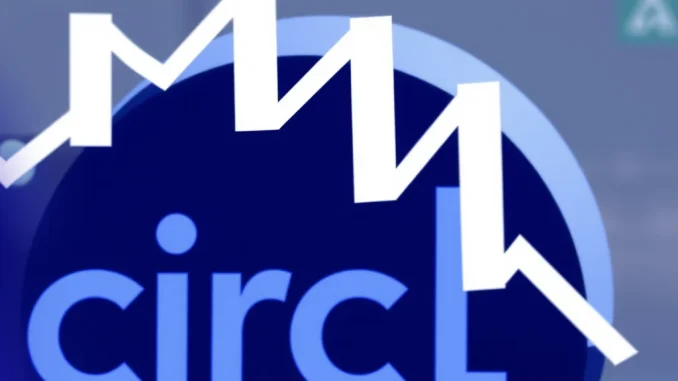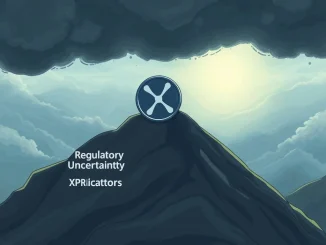
The highly anticipated Initial Public Offering (IPO) of Circle, a prominent financial technology firm known for its USD Coin (USDC) stablecoin, has ignited a flurry of discussions within the crypto community. While an IPO is often seen as a milestone of success and growth, industry experts are now voicing concerns about Circle’s financial health, specifically its profitability and valuation. Let’s dive deep into the emerging questions surrounding Circle’s IPO and what it means for the future of stablecoins and the broader cryptocurrency market.
Why is Circle’s IPO Raising Eyebrows?
Recent reports, notably from BeInCrypto, highlight a critical perspective from financial analysts regarding Circle’s IPO. Matthew Sigel, Head of Digital Assets Research at VanEck, points to a worrying trend: despite a 16% year-over-year revenue increase, Circle’s core earnings metrics are showing signs of weakness.
- EBITDA Decline: Earnings Before Interest, Taxes, Depreciation, and Amortization have decreased by a significant 29%.
- Net Income Drop: Net income has plummeted by a concerning 42%.
These figures paint a picture of diminishing profitability, even as revenue grows. Sigel suggests that this downturn could be attributed to Circle’s rapid expansion strategies, costly integrations of new services, and the discontinuation of certain revenue streams like Circle Yield. Is rapid growth masking underlying financial strains?
The $5 Billion Question: Is Circle’s Valuation Justified?
Adding to the scrutiny is the question of Circle’s $5 billion valuation. Crypto analyst Omar raises valid points about the factors influencing this valuation, particularly in the current economic climate and regulatory landscape.
- High Distribution Costs: Stablecoin businesses often grapple with significant distribution costs, impacting their bottom line.
- Shrinking Gross Margins: Erosion of gross margins can squeeze profitability and raise concerns about long-term financial sustainability.
- U.S. Deregulation Risks: Potential deregulation in the U.S. market could disrupt Circle’s business model and create new competitive pressures.
These points collectively challenge the assumption that a high valuation is automatically justified, especially when fundamental financial metrics are under pressure. Is the market overestimating Circle’s current standing and future potential?
Stablecoin Sector Dynamics: Growth Opportunities and Acquisition Scenarios
Despite the concerns, there are also perspectives suggesting potential pathways for Circle to navigate these challenges. Wyatt Lonergan, General Partner at VanEck, proposes that strategic partnerships within the stablecoin sector could be a driver for growth. Stablecoins are increasingly integral to the crypto ecosystem, and effective alliances could expand Circle’s reach and utility.
However, Lonergan also presents an alternative, and perhaps less optimistic, scenario: a discounted acquisition by Coinbase. Poor market conditions, combined with the aforementioned financial pressures, could make Circle a target for acquisition, potentially at a valuation lower than initially anticipated. This raises the question: Could Circle become a strategic acquisition target rather than a thriving independent public company?
Navigating the Crypto Landscape: What’s Next for Circle and Stablecoins?
Circle’s IPO journey is unfolding at a critical juncture for the cryptocurrency market. Several factors are converging to create a complex and potentially volatile environment:
- Market Volatility: The crypto market remains inherently volatile, impacting the valuations and financial performance of even established players.
- Regulatory Uncertainty: Global regulatory frameworks for cryptocurrencies and stablecoins are still evolving, creating uncertainty for businesses in this space.
- Competitive Pressure: The stablecoin market is becoming increasingly competitive, with new entrants and established players vying for market share.
For Circle to thrive post-IPO, addressing profitability concerns will be paramount. This may involve:
- Optimizing Operational Costs: Streamlining operations and managing distribution expenses effectively.
- Diversifying Revenue Streams: Exploring new revenue opportunities beyond core stablecoin operations.
- Strategic Partnerships: Forging alliances to expand market reach and product offerings.
Cryptocurrency Valuation in Question: Broader Implications
The questions surrounding Circle’s IPO extend beyond just one company. They reflect broader concerns about cryptocurrency valuation in general. Are valuations in the crypto space accurately reflecting underlying financial health and long-term sustainability? Circle’s experience could serve as a case study, highlighting the importance of rigorous financial analysis and due diligence, even in rapidly growing and innovative sectors.
For investors and industry participants, the key takeaways are clear:
- Financial Health Matters: Revenue growth alone is not enough; sustainable profitability is crucial for long-term success.
- Valuation Scrutiny is Essential: Thoroughly assess valuations against financial fundamentals and market realities.
- Regulatory Awareness is Key: Stay informed about evolving regulatory landscapes and their potential impact on crypto businesses.
Conclusion: A Critical Moment for Circle and the Stablecoin Ecosystem
Circle’s IPO is more than just a company going public; it’s a litmus test for the stablecoin sector and a reflection of the broader cryptocurrency market’s maturity. The concerns raised about financial health and cryptocurrency valuation are valid and warrant close attention. Whether Circle can overcome these challenges and solidify its position as a leading player remains to be seen. However, one thing is certain: the journey ahead will be closely watched by the entire crypto industry, and its outcome will have significant implications for the future of stablecoins and digital finance.



